
Lab Contributes to Nobel Peace Prize and Landmark Sustainable Energy Report
Charity Campaign One Measure of ‘Good Neighbor’
Lab Contributes to Nobel Peace Prize and Landmark Sustainable Energy Report
No problem looms as large as climate change and the world’s booming energy demand, and few institutions are as instrumental in finding solutions as Berkeley Lab. This became clear this month amid two headline-grabbing developments, which together underscore the Lab’s central role in both framing the crisis and offering a way out.
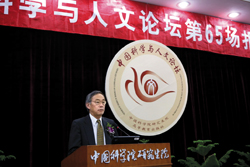
Berkeley Lab Director Steve Chu addressing the Chinese Academy of Sciences
On Oct. 22 in Beijing, China, the InterAcademy Council will release a much-anticipated report co-chaired by Lab Director Steve Chu that establishes a roadmap for a global transition to a clean, affordable, and sustainable energy supply in both developing and developed countries. Chu briefed Chinese Premier Wen Jiabao on the landmark report, entitled Lighting the Way: Toward a Sustainable Energy Future, last week in Beijing.
And earlier this month, the Nobel Peace Prize was jointly awarded to former Vice President Al Gore, Jr. and the Intergovernmental Panel on Climate Change (IPCC), an international collaboration of several thousand scientists that assesses what is known about climate change, its impacts, and how to stop it. Several current Lab scientists are important contributors to the IPCC.
First, the report. The Inter-Academy Council was created by the world’s science academies in 2000 to mobilize the best scientists and engineers worldwide to provide advice to international bodies such as the United Nations and the World Bank.
Its latest report, Lighting the Way, was commissioned by the governments of Brazil and China, and produced by an international panel of 15 renowned energy experts led by Chu and Jose Goldemberg, former Secretary of State for the Environment for the state of São Paulo, Brazil. The study is intended to provide decision-makers in both developing and industrialized countries with the scientific analyses necessary to address today’s major energy challenges.
Chu said the study represents the collective view of representatives of national academies throughout the world, and is one of the first such studies written without the vantage point of particular countries or groups.
“This report will be one of the tools that we hope will help scientists in their countries to engage the problem and to communicate with their policy makers,” Chu said. “It stresses the urgency of the problem, and the need for technological innovation as well as policies to help guide countries toward sustainable development.”
Central to the report’s findings is the premise that there are solutions to the energy and climate change problem. The report concludes that meeting the basic energy needs of the poorest people on the planet is a moral imperative that must be pursued in concert with sustainability objectives. At the same time, strong efforts must be made to improve energy efficiency and reduce the carbon intensity of the world economy. Other recommendations focus on the need for carbon sequestration, R&D investment, the development of oil and natural gas alternatives and conservation practices, and nuclear power.
It also concludes that renewable energy offers immense opportunities, but adds that the environmental impacts associated with the large-scale deployment of renewable energy technologies must be assessed. Ultimately, the science and technology community — together with the general public — must be effectively engaged.
The 2007 Nobel Peace Prize was awarded on Oct. 12 jointly to the IPCC and Gore “for their efforts to build up and disseminate greater knowledge about man-made climate change, and to lay the foundations for the measures that are needed to counteract such change.”
William Collins and Inez Fung of the Earth Sciences Division (ESD), and Mark Levine, Surabi Menon, Evan Mills, Lynn Price, Jayant Sathaye, and Ernst Worrell of the Environmental Energy Technologies Division (EETD) are among current members of Berkeley Lab who are leading authors of this year’s IPCC working group reports.
In addition to those named above, other current Berkeley Lab scientists who have contributed to the 2007 reports, or are authors of the IPCC’s Third Assessment Report issued in 2001 or other past reports, include Norm Miller, Curt Oldenburg, and Karsten Pruess of ESD and Phil Haves, Maithili Iyer, and Stephane de la Rue du Can of EETD.
“The Nobel Peace Prize recognizes the value of scientific input into this very complex discussion on climate change, and it gives the IPCC greater credibility,” said Levine, the coordinating lead author of the latest report’s residential/commer-cial chapter, and a participant in the IPCC process since 1995.
“And it says a lot about Berkeley Lab,” Levine added. “Most of this work is unfunded, and the fact that many Lab scientists contribute to the IPCC indicates that we are willing to contribute to the public interest in a big way. We work here at the Lab to accomplish valuable goals.”
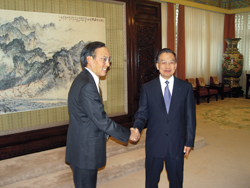
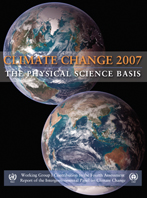
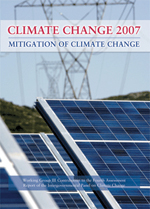

Director Chu greets Chinese Premier Wen Jiabao, above. Right, the Intergovernmental Panel on Climate Change, recently awarded the Nobel Peace Prize, has produced numerous reports documenting global climate change, its impacts and solutions.
Sathaye, the coordinating lead author of the latest report’s sustainable development and mitigation chapter, and a participant in the IPCC process since 1990, said, “With the Nobel Peace Prize, the IPCC’s findings will be received with more authority than before, and that will help push forward many of the solutions. All of the technologies and policies to mitigate climate change exist, but the willingness to implement these solutions is lacking. The Nobel Peace Prize gets out the message that these technologies and policies can be implemented in a credible manner and in a cost effective way.”
The Chairman of the IPCC, Rajendra Pachauri, sent a letter to the lead authors of this year’s reports, remarking, “I have been stunned in a pleasant way with the news of the award of the Nobel Peace Prize for the IPCC. This makes each of you a Nobel Laureate and it is my privilege to acknowledge this honour on your behalf.... The fact that the IPCC has earned the recognition that this award embodies, is really a tribute to your knowledge, hard work and application.”
Berkeley Lab’s contributors are among the thousands of scientists from more than 100 countries who have helped the IPCC alert the world to humanity’s role in global warming since the IPCC’s founding by the World Meteorological Organi-zation and the United Nations Environment Program in 1988.
Charity Campaign One Measure of ‘Good Neighbor’
The good news is that for the 10th straight year, Berkeley Lab is sponsoring a charitable giving campaign called SHARES — Science for Health, Assistance, Resources, Education and Services.
The campaign kicks off today at the SHARES Runaround and runs through Nov. 16.
It’s a great way for all employees to assist non-profit health and service agencies while supporting the Lab’s commitment to the community. Employees can contribute by filling out a donation form — which was sent to everyone today — and sending it to the payroll office, or by donating online at www.lbl.gov/shares/.
And now for the disappointing news: Berkeley Lab lags far behind other national labs when it comes to donating to lab-based charity campaigns. Consider the tallies from these campaigns last year: At Argonne National Lab, 3,912 participants contributed $372,013. At Pacific Northwest National Lab, 726 donations netted $399,313. At Brookhaven National Lab, an estimated 400 donations brought in an estimated $100,000. At Oak Ridge National Lab, 2,300 donations brought in $916,298. And at Lawrence Livermore National Lab, 2,625 donations brought in a whopping $1,388,717.
In last year’s Berkeley Lab SHARES campaign, 68 people donated a total of $43,670. Campaign officials noted that an institution’s support in the neighboring communities at least partly generates from the perceived involvement of the Lab in community activities. Charitable contributions from businesses and institutions are one measure of that involvement.
“Berkeley Lab has over the decades contributed immeasurably to the quality of life through its record of scientific excellence,” said Director Chu. “To all of you who contribute your own time, expertise and resources to help local organizations, I commend your efforts. Please consider Berkeley Lab SHARES as an additional opportunity to help make a difference for our neighbors and our world.”
The SHARES campaign makes it easy to contribute. Any 501(c)3 organization is eligible to receive a donation. In addition to Berkeley Lab SHARES, which encompasses local charities that support science education and energy conservation, options may be found among the following organizations: Community Health Charities of California, United Way of the Bay Area, Earth Share of California, the Bay Area Black United Fund, Local Independent Charities, and Global Impact.
How do donations benefit the participating organizations? Last year, Adult Day Services of Alameda County, a member of the Local Independent Charities federation, covered the costs for 60 home modifications across Alameda County, including the installation of grab bars, fire extinguishers, stair rails, and portable wheelchair ramps. And Our City Forest, a member of the Earth Share of California federation, planted more than 2,000 trees in San Jose and Santa Clara County. There are plenty of other success stories like these, and more to be made.
Student in Life Sciences Marches with Pride as Cal’s Drum Major
With his double major in math and molecular and cell biology at Cal, as well as a research position at Berkeley Lab, senior Josh Arribere is juggling a lot of things this fall. One of them also happens to be a baton.
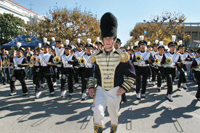
UC drum major Josh Arribere also balances a research position in the Lab's Life Sciences Division
Arribere, who works with life scientist John Conboy on alternative gene splicing, is the drum major for UC Berkeley’s marching band, a post he was elected to by his band mates this year. He marched his first three years playing the alto saxophone.
“Running for drum major is pretty involved, actually,” explains Arribere. “I had to submit a letter of intent, give speeches and take an oral exam.”
As it turns out, throwing a baton is the least important job Arribere performs as drum major — he only does it once, before each game, as the band marches onto the field. Ninety-nine percent of his time is spent putting together the pre-game and halftime shows, reviewing music, selecting tunes, preparing choreography, and running rehearsals. It is a leadership position and crucial for the success of the band.
“The baton is just an artifact from years of tradition,” says Arribere. “I had never picked one up before this August, so had to quickly teach myself how to throw and catch it.”
He was 100 percent in successful catches — opting for a lower toss to increase his odds — until his streak ended before last week’s home game versus Oregon State (was it a precursor for the team’s first loss of the season later that day?).
Arribere clearly loves his role, eyes sparkling as he describes how unique Cal’s marching band is.
“For one thing, we use a high-step march instead of a roll-step, which is rare among college bands,” Arribere says. “Also, we are one of the only bands that is entirely student run.”
Other bands pay small salaries or offer course credit to encourage participation. At Cal, it’s a labor of love, with students volunteering out of passion and pride.
“This shows in the intensity of our performances,” says Arribere. “We’re there because we really want to be, not for money or credits.”
Among his most memorable halftime shows was the 2004 Big Game versus Stanford, during his freshman year. The program consisted of hip-hop songs that were popular in the dance clubs. Can flutes, coronets and snare drums really do justice to that genre of music? “Yes,” answers Arribere. “We actually do a really good job of interpreting hip-hop, and the students love it.”
When asked whether the football rivalry with Stanford extends to the marching band, Arribere shook his head side to side. “We actually get along well with them. It’s the USC (University of Southern California) band that’s rude to us. When we go down there, they put us in their stadium’s worst possible seats.”
Safety Coordinator Brews Her Own Award-Winning Beer
This is the month when traditional Oktoberfests are held around the world, and the elixir at the center of these celebrations is beer — the world’s oldest alcoholic beverage, dating back thousands of years.
Since that time, beer making has become a major global business, generating billions of dollars annually. But there are some out there who prefer to make their own brew — for fun, not profit.
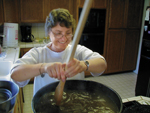
EH&S safety coordinator, Marty White, brews award-winning beer in her Petaluma kitchen
Count Marty White among the latter. White is an Environmental Health and Safety employee serving as the safety coordinator for the Nuclear Science and Physics Divisions.
About once a month, in a barn at her home in Petaluma, White and her husband can be found cooking and mashing grains, draining then cooling the concoction, then adding yeast, which changes the sugars in to alcohol — the basic process for making beer. Their label is called “Cleveland Lane” for the road they live on.
“We usually get up on a Sunday morning and make a five-gallon batch,” explains White. “It takes several hours to cook it up, then two weeks for the fermentation process, and another two weeks in the bottle before it’s ready for drinking.”
Among their creations: a schwarzbier (dark) named Lazy Kat, a blonde ale made from the South American quinoa grain called La Rubia, and an American Light lager (Mexican style) dubbed La Gitana. And when she went on the South Beach diet, White created Bankside Beach, a lo-carb London mild.
It would appear that White and her husband know what they’re doing. Their La Gitana brew won a blue ribbon at the California State Fair two years ago, and Lazy Kat earned a “very good” ranking at the all-female “Queen of Beers” contest in Reno earlier this year.
Their brews are also blind-tasted by members of the “Beerocrats,” a local home beer-making club. If a beer impresses there, then it’s sent up to the next level for tasting, as part of the American Homebrewers Association.
“No, judges don’t spit out the beer like they do wine,” laughs White. “The judges are looking at several factors: does the beer’s style match its classification, are there any off flavors, are flavors balanced, is it clear or cloudy, and, most important, is it pleasant to drink.”
When asked how her beer stacks up to others, White modestly answers: “It’s pretty good.” And what makes it so?
“My husband and I are both chemists by training, so we follow scientific methods when creating our beer,” she says. “We utilize strict sanitation practices and take copious notes so that we can reproduce our results.”
Reporters note: After sampling a bottle of the Bankside Beach London mild, I must agree with White that her beer is “pretty good.”
Berkeley Lab View
Published once a month by the Communications Department for the employees and retirees of Berkeley Lab.
Reid Edwards, Public Affairs Department head
Ron Kolb, Communications Department head
EDITOR
Pamela Patterson, 486-4045, pjpatterson@lbl.gov
Associate editor
Lyn Hunter, 486-4698, lhunter@lbl.gov
STAFF WRITERS
Dan Krotz, 486-4019
Paul Preuss, 486-6249
Lynn Yarris, 486-5375
CONTRIBUTING WRITERS
Ucilia Wang, 495-2402
Allan Chen, 486-4210
David Gilbert, (925) 296-5643
DESIGN
Caitlin Youngquist, 486-4020
Creative Services Office
Berkeley Lab
Communications Department
MS 65, One Cyclotron Road, Berkeley CA 94720
(510) 486-5771
Fax: (510) 486-6641
Berkeley Lab is managed by the University of California for the U.S. Department of Energy.
Online Version
The full text and photographs of each edition of The View, as well as the Currents archive going back to 1994, are published online on the Berkeley Lab website under “Publications” in the A-Z Index. The site allows users to do searches of past articles.
Flea Market is now online at www.lbl.gov/fleamarket
Advanced Light Source and Molecular Foundry: Where Great Minds Meet
More than 600 attendees registered for the annual user meetings for the Advanced Light Source (ALS) and the Molecular Foundry (MF), which were held on October 4-6.
Reflecting the synergy between these two national user facilities, this year’s meetings featured the first joint plenary and poster sessions. The ALS plenary talks took place in the Building 50 Auditorium, and the MF talks were held in the Building 66 Auditorium. Live video casts linked the two locations.
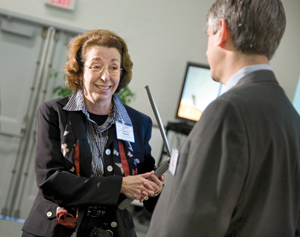
Director of Basic Energy Sciences Pat Dehmer with ALS Director Roger Falcone
Following welcoming remarks from Berkeley Lab Deputy Director Graham Fleming, the joint plenary sessions began with reports on progress and prospects for the ALS and MF, presented by their respective directors, Roger Falcone and Carolyn Bertozzi.
Highlights of Falcone’s talk included brief discussions of two new construction projects, an ALS User Support Building at the site of the recently demolished Building 10, and a Berkeley Lab Guest House at the former site of Building 29. Groundbreaking ceremonies were held on Thursday and Friday respectively for these new facilities.
Falcone had much other good news to report including upgrades to the ALS radio-frequency (RF) system, a quasi-periodic undulator for the future beamline dubbed MERLIN, and injector and lattice upgrades for the Top-off project.
Upgrading the RF system will entail replacing the klystron now used to generate RF power with four inductive output tubes by the spring of 2009. Plans also call for an upgrade of the low level RF control system, and independent sources to power the RF cavities.
In talking about the MERLIN beamline, which is designed to provide the ultrahigh resolution required for the study of strongly correlated systems, Falcone called its quasi-periodic elliptically polarized undulator “the most complicated insertion device ever to be installed at the ALS.” Installation is to begin this month and is expected to be completed in January 2008.
The ALS Top-off project calls for electrons to be injected into the storage ring every 30 seconds or so, as opposed to the present operating mode in which the storage ring is filled only once every 8 hours. This “quasi-continuous” current will increase the brightness and stability of ALS beams among other performance benefits.
“We have ambitious plans for both renewals and upgrades that will enable the ALS to continue to grow and remain a premier facility, and we are grateful to DOE for its continuing support,” said Falcone in his concluding remarks.
In her presentation, MF director Bertozzi announced that that since the opening of the MF last year, 170 research proposals have already been accepted, representing domestic and foreign scientists from academia, private industry, and national laboratories and research institutes.
Bertozzi discussed three overarching research themes that integrate the MF’s six research facilities: inorganic/organic interfaces; supramolecular synthesis and single-digit nano. She also talked about energy-related MF research activities which include studies of hydrogen storage materials, photovoltaics, light-harvesting materials, and nanoporous membranes for ethanol extraction. She then listed a dozen projects that involve both the MF and ALS.
“Users can build nanosystems at the Molecular Foundry then use the ALS to characterize the structure and properties of these systems,” Bertozzi said.
The Falcone and Bertozzi talks were followed by a presentation from Patricia Dehmer, director of DOE’s Office of Basic Energy Sciences (BES), which oversees and funds both the ALS and MF. Her talk was entitled: Five Years of Strategic Planning and Light Sources.
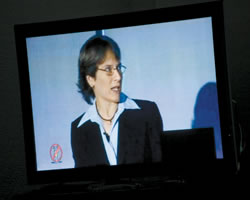
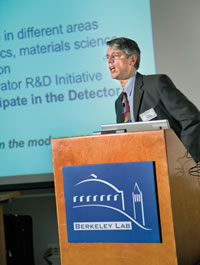 Left, Molecular Foundry Director Carolyn Bertozzi delivered her presentation to ALS users via live videocast from Bldg. 66; right, Roger Falcone Addresses users
Left, Molecular Foundry Director Carolyn Bertozzi delivered her presentation to ALS users via live videocast from Bldg. 66; right, Roger Falcone Addresses users
Dehmer opened with powerpoints showing current U.S. energy consumption at about 100 Quads (quadrillion BTUs), with about one-third of this being imported. She pointed out that the overall efficiency of our energy usage in the 1950s was actually greater than it is today, with the biggest waste occurring in the transportation and electric power sectors. It is no surprise then that those two sectors account for most of this country’s carbon dioxide emissions.
“By 2100, world energy consumption may triple and U.S. energy consumption may double,” Dehmer said, “so we need to find another 100 Quads of energy by the end of this century.”
To help meet this goal, she called for a new era of science that will lead to next-generation energy technologies.
“The 21st century should be the Age of Control,” Dehmer said, “where we direct and control electrons, atoms and nanoscale entities; emergent phenomena; and nonequilibrium processes.”
Dehmer said that light sources will be among the most powerful tools for this achieving this goal and cited plans for new facilities in the 21st century. First up will be the Linac Coherent Light Source (LCLS) at SLAC, the first linear accelerator source of hard x-rays, expected to begin operations by 2011. Next will be the National Synchrotron Light Source II at Brookhaven National Laboratory, an advanced ultrabright storage-ring light source, expected to be operating by 2015.
“By 2015, with LCLS and NSLS-II newly operating, the youngest of today’s BES light sources will be approaching its 20th birthday,” Dehmer said. “Now is the time for DOE and the scientific community to begin the process of strategic planning for the 21st century light sources that will be as impactful as today’s light sources and address the scientific needs of the community in the 21st Century.”
Remembering Gary Krebs
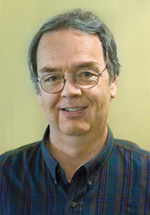
A plaque honoring Krebs will be placed in the Guest House.
On Oct. 5, about thirty minutes before a groundbreaking ceremony for the Berkeley Lab Guest House, people gathered in the Building 50 auditorium to share memories of a person whose vision and effort helped make that event possible.
Gary Krebs, the ALS user services group leader and deputy science advisor, passed away in May. He joined Berkeley Lab in 1983 and embarked on an illustrious career in which he coordinated several accelerator improvement projects at the Bevatron and the ALS. He also played prominent roles in safety, education, and workforce diversity efforts.
Among the audience were Krebs’ wife, son, and friends, as well as several people who paid tribute to a person who, in his ever calm and gentle way, helped make the Lab what it is today.
“For the last three years, working closely with Gary, I really came to admire his integrity and commitment to causes he believed in, such as justice, diversity, and fairness,” said Janos Kirz, who served as interim director of the ALS from 2004 to 2006. Peggy McMahan of the Nuclear Sciences Division, who joined the Lab at about the same time as Krebs, and who worked with him on the diversity council, said, “The words that come to mind when thinking about Gary in his work life is dedication and determination.”
Gentlemen, Start Your ’Dozers
Four Construction Projects Will Keep Lab Hopping for Next Two Years
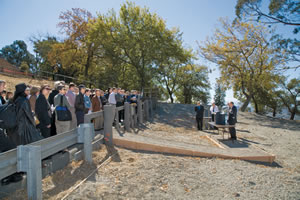
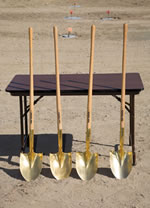
Deputy Director Graham Fleming addresses the crowd at the Guest House groundbreaking ceremony
Deputy Director Graham Fleming participated in two groundbreaking ceremonies for new buildings earlier this month, and in late September he listened to Director Steve Chu and Institutional Assurance Director Jim Krupnick describe two other buildings scheduled for construction starts next year.
So it is understandable that one of his messages to the assembled guests at the first of the ceremonies was “have patience.” This suggestion will especially apply when the heavy equipment, earth movers, delivery trucks and various other intrusions at four building sites make the Hill in 2008 look like a major candidate for “Extreme Makeover, Research Edition.”
Not to mention the ongoing activities associated with the deconstruction of the Bevatron.
On the flip side of the coin, the Lab hasn’t seen burgeoning growth like this in decades, a sign of prosperity and strong support for science. So with patience should come pride in these visible votes of confidence.
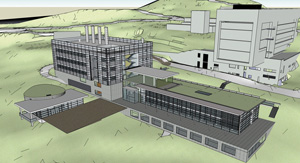 An architect’s rendering of the proposed Helios Energy Research Facility reveals its place alongside the Molecular Foundry. The Helios Facility will house both Berkeley Lab research and the Energy Biosciences Institute
An architect’s rendering of the proposed Helios Energy Research Facility reveals its place alongside the Molecular Foundry. The Helios Facility will house both Berkeley Lab research and the Energy Biosciences Institute
Basic Energy Sciences Director Pat Dehmer offered a big vote at the Oct. 4 groundbreaking for the Advanced Light Source User Support Building (USB). She called the ALS “the best light source in the country in terms of science productivity;” hence her relentless efforts, cited by several speakers, to keep the USB alive in the budget when the Congressional axes were falling everywhere.
“This is a tribute to how hard Pat worked,” Fleming said. “It went away, then it came back, then it went away again. She has been the key person in making this happen.” ALS Users Group President Tony Van Buuren of Livermore Lab echoed the praise. “I know how difficult it was to make this a reality. Pat took it to heart, and it became a mission of hers.”
The “mission” will be a 30,000-square-foot three-story structure on the west side of the ALS, where Building 10 used to be. The experimental facility’s meteoric growth in beamlines and users virtually eliminated valuable set-up and office space. The USB will have a high bay for endstation assembly, seminar room, modern analytical laboratories, and office space for 85. Construction is scheduled to begin next March and the building will be ready for occupancy in the summer of 2009.
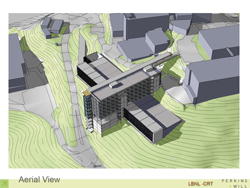
The Computational Research and Theory Facility (CRT), located on the hillside below Buildings 50 and 70, will allow the National Energy Research Scientific Facility (NERSC) to return to Berkeley Lab from a leased facility in Oakland.
The next day, hundreds of users attending three days of joint ALS-Molecular Foundry scientific meetings found yet one more reason to rejoice. Their pleas over the years for a low-cost, customer-centered, short-term accommodation option on site were answered when ground was broken for the Berkeley Lab Guest House, a 70-bed, 25,000-square-foot lodging facility just west of Building 2.
“Now users will be able to sleep when they need to, and work when they need to,” said Fleming, who hosted the Oct. 5 ceremony. “This Guest House will not only make it possible for our visitors to be more productive while using our facilities, but also it will offer opportunities for valuable interactions among scientists, students and staff from institutions worldwide. It will also promote Berkeley Lab’s user facility leadership position within the DOE complex and enhance the Lab’s chances of DOE funding for other programs.”
He especially thanked the University of California, represented by Assitant Vice President for Laboratory Administration Bob Van Ness of the UC President’s Office, for helping the Lab acquire external financing for construction, which will begin in December; and the Howard Hughes Medical Institute, which will pay for the furniture, fixtures and equipment. First guests should be checking in around March 2009.
Berkeley Lab includes “the world’s elite scientists,” Van Ness said, and a guest house like this is needed to maintain its status as a world-class scientific institution . . . and to enhance the Lab’s user-friendliness.”

Director Steve Chu addresses Lab employees during a Sept. 24 brown-bag talk in which he discussed the proposed Helios and CRT buildings.
…And Further in the Future: Helios and CRT
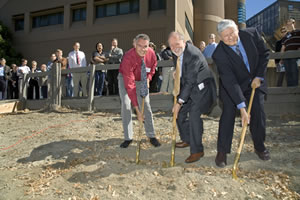
Graham Fleming, center, flanked by ALS Users Group President Tony Van Buuren, left, and Robert Van Ness, break ground for the new Berkeley Lab Guest House, which will offer a low-cost, customer-centered, short-term accommodation option on site.
If there is one image that portrays why Berkeley Lab is proposing to build the Helios Energy Research Facility and the Computational Research and Theory (CRT) Facility, this is probably it: A famous photograph taken from the 1968 Apollo 8 mission, which depicts the Earth — small and blue and swirled with white clouds — rising above the moon’s barren landscape.
“This is an incredible picture because it shows the stark contrast between what most of the universe looks like, and what we look like,” said Chu. “And this is worth protecting.”
Chu showed the image to Lab employees at a Sept. 24 brown-bag talk in which he discussed the two facilities, which are in the late planning stages. Draft Environmental Impact Reports for the two buildings are expected to be issued in early November; both are expected to break ground next year and open for business in the 2010-11 time frame.
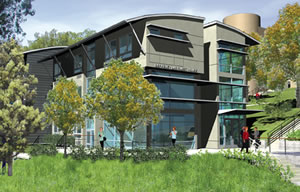
The Berkeley Lab Guest House, shown in architects rendering, will be a 70-bed, 25,000 square-foot lodging facility just west of Building 2. It will serve scientists from around the world as they come here to conduct research at the Lab’s various user facilities.
The Helios Energy Research Facility, to be located just west of the Molecular Foundry, will enable scientists to harness the sun’s energy in new ways. It will house both Berkeley Lab research and the Energy Biosciences Institute, a BP-funded partnership between Berkeley Lab, UC Berkeley, and the University of Illinois at Urbana-Champaign. Research will concentrate on developing renewable transportation fuel from biomass, a new generation of solar photovoltaic cells, and the conversion of electricity into chemical storage to meet future demand.
The 160,000-gross-square-foot, five-story building will boast an auditorium, cafeteria, and innovative energy efficiency features. Krupnick, who also spoke at the brown bag, said the building will have green roofs that provide natural cooling, and make aggressive use of photovoltaics and solar shading, high-efficiency glazing, and natural ventilation and lighting.
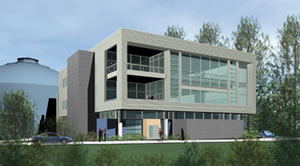
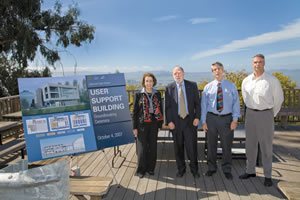
Top: Architects rendering of the Advanced Light Source User Support Building. The 30,000-square-foot structure on the west side of the ALS will have a high bay, laboratories, a seminar room and office space. Bottom: At the groundbreaking for the User Support Building, from left to right, Director of Basic Energy Sciences Pat Dehmer, Lab Deputy Director Graham Fleming, ALS Director Roger Falcone, and Tony Van Buuren.
The CRT facility, to be located on the hillside below Buildings 50 and 70, will allow the National Energy Research Scientific Computing Center (NERSC) to return from a leased facility in Oakland to Berkeley Lab. Key research areas expected to benefit from bringing the computing facility back to the main site include biological and environmental research, fusion energy research, basic energy science, astrophysics, and climate change research.
The 140,000-gross-square-foot facility will increase NERSC’s available computer area and be one of the most energy-efficient buildings of its kind. The office tower is designed to have minimal solar exposure to the west, and the computer room will be cooled approximately 85 percent of the time using outside air, thanks to Berkeley’s cool climate. Both facilities will be UC buildings, with construction managed by Berkeley Lab staff.
More Energy Efficiency Improvements on the Way
October is Energy Awareness Month, and while everyone at Berkeley Lab should do their part by turning off lights and computers when not in use, Michael Dong, a chief engineer in the Facilities Division, is embarking on a more far-reaching task.
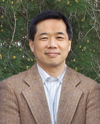
Michael Dong
He’s working with his counterparts at other DOE national labs as part of an initiative to reduce the energy intensity in the DOE complex by 30 percent. This means that during the next several months, no stone will be left unturned as he and other Facilities Division staff work to make the Lab as energy efficient as possible. Vehicles, lights, computers, heating, cooling, ventilation, water — everything that consumes energy will get a once-over to determine if it can be made more efficient.
Dong’s work was set in motion in January, when President Bush signed an executive order that stipulates that all federal agencies must reduce greenhouse gas emissions by 30 percent from 2003 levels by the end of fiscal year 2015. Also, beginning this year, federal agencies must reduce energy intensity by 20 percent and water consumption by 16 percent from 2007 levels by 2015. The order also establishes targets for reductions in petroleum use, and increases in energy efficiency and utilization of sustainable building practices, among other goals.
In August, in response to this order, DOE Secretary Samuel Bodman announced the Transform-ational Energy Action Management (TEAM) Initiative, a Department-wide effort that aims to meet or exceed the goals outlined in the executive order. The initiative requires that by 2008, DOE should have plans that specify how all of its facilities will reduce energy intensity by 30 percent.
But that’s just the start. Bodman also said that DOE should lead all federal agencies in several key categories, such as energy efficiency, renewable energy generation and use, and petroleum reduction and alternative fuel use in its fleets.
“DOE believes that it should set the example and lead the way in meeting and exceeding the goals of the executive order,” says Dong. “And if DOE is going to lead the way, its national labs should lead DOE, which means us.”
Reducing energy intensity by 30 percent will be relatively easy for labs that have only recently begun implementing efficiency measures, Dong explains. However, others, like Berkeley Lab, which have been curbing energy consumption for decades, will make achieving an additional 30-percent reduction a huge hurdle.
Because of this, the national labs have formulated a portfolio approach to implementing the TEAM initiative. Together, all 18 DOE laboratories will tackle the goals outlined in the executive order. In some cases, for example, this means that one lab will only have to cut greenhouse gas emissions by 15 percent if another lab slashes emissions by 45 percent.
“This portfolio approach assures that the labs will comprehensively meet the goals, and targets the most cost effective opportunities in achieving compliance,” says Dong.
The labs won’t go it alone either. Another cost-saving approach under the TEAM Initiative is recruiting the help of an energy efficiency consulting company. Under this approach, a company contracted through DOE provides the initial capital costs of equipment purchases and process enhancements at a lab. The lab then uses the revenues generated from these energy efficiency improvements to repay the loan. Berkeley Lab is currently evaluating a contract proposal from one such company, which has drafted a strategy that could enable the Lab to exceed the goals of the executive order and the TEAM Initiative.
“It will require innovation, new ideas, and most importantly, all of us at Berkeley Lab to make this a reality. However, we are confident that we can meet this challenge,” says Dong.
Daya Bay Groundbreaking ceremony
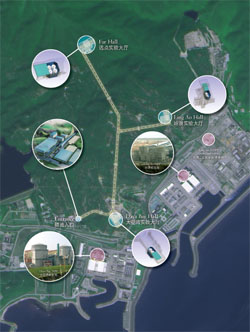
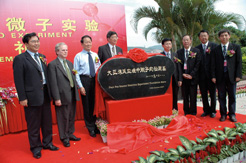
At a groundbreaking ceremony Oct. 13 Robin Staffin, Associate Director of DOE's Office of High Energy Physics (second from left), joined Chinese officials (from left) Chunli Bai, Executive Vice President of the Chinese Academy of Sciences, Jinpei Cheng, Vice Minister of the Chinese Ministry of Science and Technology, Hesheng Chen, Director of the Institute of High Energy Physics, Yangsheng Zhon, Executive Vice Governor of Guangdong Province, Wenqing Shen, Vice President of the National Natural Science Foundation, Ming Li, Vice Mayor of Shenzhen, and Yu He, CEO of the Guangdong Nuclear Power Group, along with members of the Daya Bay Collaboration, in launching the international Daya Bay Reactor Neutrino Experiment. One of the largest-ever cooperative scientific projects between China and the U.S., the experiment will begin taking data in 2010 and will measure "theta one three," the parameter describing a mysterious form of neutrino oscillation.
“At the ground where we now stand, scientists will measure with the world’s greatest precision one of the most important parameters of nature,“ Staffin said.
Jinpei Cheng credited the “efforts and wisdom of the scientists,” and added, “I believe the Daya Bay Reactor Neutrino Experiment will achieve a full success.“
Berkeley Lab, represented by Associate Laboratory Director for General Sciences Jim Siegrist, leads U.S. participation in the experiment, with Kam-Biu Luk of the Physics Division as U.S. scientific spokesperson, and Bill Edwards of Engineering as U.S. project manager for construction; all three were on hand for the ceremonies.
The experiment will house eight 100-ton antineutrino detectors in tunnels extending three kilometers beneath the mountains adjacent to the powerful Daya Bay reactor complex, located some 55 kilometers northeast of Hong Kong. Neutrinos (and their antiparticles) come in three kinds which, because neutrinos have mass, change into one another, or oscillate. Learning about the new kind of neutrino oscillation may explain why there is much more matter than antimatter in the universe, making human existence possible.
DePaolo Named Earth Sciences Division Director
Don DePaolo, a senior faculty scientist and renowned geochemist who has conducted research at Berkeley Lab and UC Berkeley since 1988, has been named director of the Lab’s Earth Sciences Division. DePaolo replaces acting director Ernie Majer, who managed the division following the untimely death of Bo Bodvarrson last Nov. 29.

Don DePaolo
DePaolo said the division will especially focus on energy resources, climate change and its impacts on energy, and water resources, "and fundamental science underlies it all." He anticipates working closely with both the Energy Biosciences Institute and the Joint BioEnergy Institute, and he looks to increasing Earth Sciences' interlaboratory research interactions with other divisions.
DePaolo most recently served as head of the Earth Sciences Division’s geochemistry department. He also established and directs the Center for Isotope Geochemistry, a joint research facility between Berkeley Lab and UC Berkeley. DePaolo is also the Class of 1951 Professor of Geochemistry in UC Berkeley’s Department of Earth and Planetary Science.
His research interests include applications of mass spectrometry and isotope geochemistry to fundamental problems in geology, origin and evolution of the earth’s continental crust and mantle, radiometric dating of igneous, metamorphic, and sedimentary rocks, and isotopic hydrology and oceanography. He received a Ph.D. in geology from the California Institute of Technology in 1978.
People, Awards, and Honors
Lab Nuclear Scientist Wins 2008 Bonner Prize

Art Poskanzer, a Distinguished Senior Scientist Emeritus in Berkeley Lab’s Nuclear Science Division (NSD) and 41-year Lab veteran, has won the American Physical Society’s 2008 Tom W. Bonner Prize. The award honors “his pioneering role in the experimental studies of flow in relativistic heavy ion collisions.” Awarded by APS’ Division of Nuclear Physics to recognize and encourage outstanding experimental research in nuclear physics, the Bonner Prize includes a $7,500 award and a certificate citing the recipient’s contributions.
Lab Physicist Elected Chair of LHC Group

Berkeley Lab physicist Michael Barnett has been elected to be the first-ever chair of the U.S. Large Hadron Collider (LHC) Users Organization Executive Committee. The LHC is scheduled to begin operation next summer, conducting six projects, including Berkeley Lab’s ATLAS experiment, of which Barnett is a member. The LHC User Organization will assist U.S. scientists with housing, office space, and communication needs, as well as keeping policymakers updated on the progress of LHC experiments.
Popular Mechanics Award For Gadgil and Galitsky
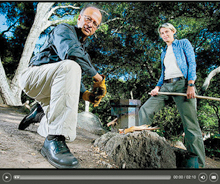
Ashok Gadgil and Christina Galitsky
Popular Mechanics magazine has given a 2007 Breakthrough Award to Berkeley Lab scientists Ashok Gadgil and Christina Galitsky, and the team that developed the energy efficient Darfur stove. The Environmental Energy Technologies Division researchers are among eight inventors and teams honored in the magazine’s third annual awards.
Chemist Named to National Science Medal Committee

A UC Berkeley professor and Berkeley Lab nuclear scientist renowned for her discoveries in nuclear chemistry was appointed by President Bush last month to the President’s Committee on the National Medal of Science. Darleane Hoffman, who received a National Medal of Science of her own in 1997, will join 11 other former medalists in reviewing nominations and recommending honorees to the President for the medal, the nation’s highest scientific honor.
Lab Materials Scientist Joins Hydrogen Group
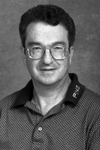
Phil Ross, a senior scientist with Berkeley Lab’s Materials Sciences Division, has been appointed to the Department of Energy’s Hydrogen and Fuel Cell Technical Advisory Committee (HTAC). Established by the Energy Policy Act of 2005, the HTAC reports to the Secretary of Energy and advises on hydrogen fuel cell program goals, objectives and policies. Ross is a leading authority on electrochemical research. Most recently he helped identify a platinum-nickel alloy that is the most active oxygen-reducing catalyst ever reported. Hydrogen fuel cell development has been severely hampered by slow oxygen-reduction catalysis.
Gray Gets Breast Cancer DOD Innovator Award

A grant totaling almost $8 million has been awarded to Joe Gray, director of Berkeley Lab’s Life Sciences Division, in the form of an Innovator Award from the Department of Defense Breast Cancer Research Program. The Defense Department is the second largest funding agency for breast cancer research in the world. Gray leads a multi-institutional team with collaborators from UC San Francisco, UC Berkeley, Berkeley Lab, and Livermore Lab. The goal of their project is to greatly improve breast cancer screening and reduce mortality from breast cancer.
Nuclear Scientist Elected To LHC User Committee

Berkeley Lab nuclear scientist Peter Jacobs was elected as one of 12 members of the new U.S. Large Hadron Collider User Organi-zation’s Executive Committee. Jacobs is a member of LHC’s ALICE (A Large Ion Collider Experiment) team, which seeks to recount the birth of matter. The LHC User Organization will assist U.S. scientists with housing, office space, and communication needs, as well as keeping policymakers updated on the progress of LHC experiments.
Astrophysicist Joins NASA Definition Team

Julian Borrill, an astrophysicist in the Lab’s Scientific Computing Group, has been invited to join NASA’s Primordial Polarization Program Definition Team (PPPDT), charged with planning the cosmic microwave background radiation (CMB) polarization mission after the upcoming Planck satellite mission. Borrill, Chris Cantalupo, and Ted Kisner have been doing extensive simulations based on the amount of data expected to be gathered by the 74 detectors on the Planck satellite.
In Memoriam
Gammasphere Pioneer Diamond

Dick Diamond, nuclear chemist and senior staff scientist emeritus with Berkeley Lab, passed away on Sept. 14 after a brief illness. He was 83. Diamond and his Lab colleague Frank Stephens worked on high-spin nuclear structure and helped develop the gamma-ray detector “Gammasphere.” His son Rick Diamond, a scientist in Enviro- nmental Energy Technologies, said a memorial service will be scheduled in a few months. Contributions in Diamond’s name can be made to the Alzheimer’s Services of the East Bay and the Sierra Club.
Renowed Particle Physicist Pief Panofsky

Wolfgang “Pief” Panofsky, professor of physics at Stanford and Director Emeritus of the Stanford Linear Accelerator Center (SLAC), died of a heart attack on Monday. He was 88 years old. Panofsky was a renowned particle physics researcher, an accelerator builder and an administrator of basic research. In parallel with his science career, he pursued two other interests of interrelated historical significance: nuclear arms control and international peace and security. In 1945 Panofsky began work as a staff physicist at UC Berkeley’s Radiation Laboratory, which later became Berkeley Lab.
HILAC Engineer Newell
George Newell, Jr. died at his home in Alameda on Sept. 25 after a long illness. He was 84. Newell served in the Army from 1942 to 1946 then, in 1956, began working at the Rad Lab (Berkeley Lab’s former name) on the Heavy Ion Linear Accelerator (HILAC). During his tenure, he assisted the scientific team that discovered the elements Ruther-fordium (104) in 1969 and Seaborgium (106) in 1974. He retired as a Staff Scientist Mechanical Engineer in 1984. Donations in Newell’s name can be sent to the National Parkinson Foundation.